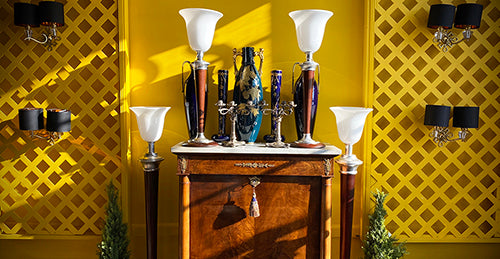Edgar Brandt

THE BIOGRAPHY OF EDGAR BRANDT
Edgar Brandt was born in Paris, on the Eve of Christmas, 1880, into a protestant family originally from the Alsace region in the east of France. His father directed a company that worked construction in metal. They later moved to the city Orléans to the south of Paris when Edgar was six.Interest in his father’s work prompted Edgar to enroll in 1894 at the École Nationale Professionelle de Vierzon, where he studied metallurgy. He soon discovered an extraordinary talent for the subject, and also realized that he had an intensely creative side that he began to apply to his metal work. He graduated from the school in 1898, soon after which he began his military service as part of the 153rd Infantry posted in the city of Nancy. He rejoined civilian life a couple of years later, and in 1901, he set up his first workshop in Paris.
Brandt exhibited his new work at the Salon des Artistes Décorateurs in Paris in 1903. From this time on, he regularly contributed to the various salons held in Paris.
Brandt’s work was awarded a 1st class gold medal at the Salon des Artistes Français held in 1908. It led to his immediate fame both within Europe and elsewhere. He received the commission to work on the Bank Paul in Nancy in 1913, along with another at the town theater. However, World War I saw him being mobilized again. He soon noticed a lack of light long-range weapons, and began conceiving designs for them. He began designing and producing these at his workshop, along with jewelry and artworks, when he returned to Paris a year later. He began creating and supplying weapons to the French army through the war.
Brandt was named Chevalier de la Légion d’Honneur in 1921. Two years later, he received a Medaille d’Honneur from the Société des Artistes Français. By then, his style had changed, and the employment of cleaner lines and geometric forms had led to what in 1925 came to be known as Art Deco. The seminal Internationale des Arts Décoratifs et Industriels Modernes (from which Art Deco took its name) was held that year in Paris, and Brandt’s work was central to it. He also set up an art gallery, “Galerie Edgar Brandt,” in Paris that year, where he exhibited both his work as well as Art Deco pieces by other artists. A year later, he founded the “Société des Etablissements Brandt.” And a clear demarcation between his artistic and military work was established.
The workshop moved outside Paris to Châtillon-sous-Bagneux in 1932. It was a large enterprise, with Brandt now employing 1,000 people there. This permitted for huge orders and commissions being created fairly quickly. Brandt’s work was commissioned and exported to countries around the globe. The company was taken over by the government in 1936.
World War II led to Brandt moving to Switzerland with his family in 1942. He fell ill soon after, and eventually died in Geneva in 1960.












